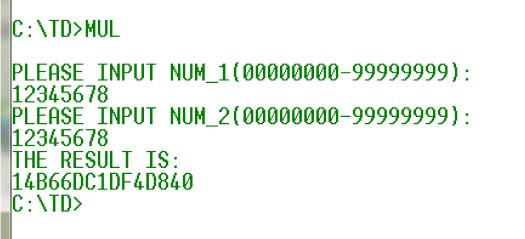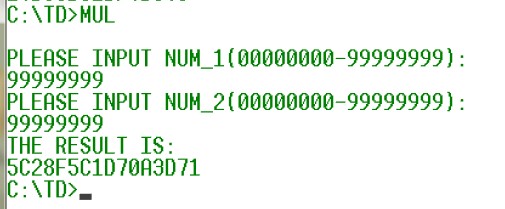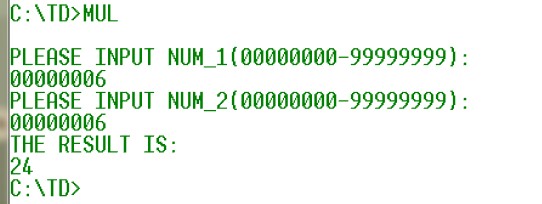This is the content of "Principles and Interface Technology of Microcomputer" in the course design of the school. I have written some drawbacks, but basically realized the operation function. I will record it temporarily for future review, which is also for your reference.
Defects:
1. Only fixed length input (32 bits corresponding to 00000000 -- FFFFFF)
2. For example, an input of 6 (hexadecimal) can only resemble an input of 00000006
3. Only 0-9 inputs from 0-F are considered, and neither A-F nor A-F are considered.
I have no time to modify it for now, I may write it later
Experimental environment:
1. I debugged Windows 7 on a virtual machine. The cpu displayed in TD debugging is 80486, but this experiment requires 8086 (16 bits). This does not affect, because the 80486 instruction set is forward compatible as long as we write 8086 instructions.
The reason for this is that 80486 already has a new instruction set that allows 32-bit operations directly.
2.... No more >==<!
Design ideas:
Input:
Input, because INT 21 (01H) is called for input, and the function call can only enter one character at a time, and the data stored in AL is its ASCII value, so the input value must first be converted to real data, while adding a loop to complete the input of fixed-length data.
Operation:
Since only 16-bit data can be computed at one time in the 8086 system of 16-bit registers, when we need to perform 32-bit operations, consider segmenting. The result data of each segmentation (DX:AX) is placed in the corresponding memory address (labeled HH, HL, LH, LL).Take 32-bit data DX:AX as an example. Data is divided into high (H) and low (L). Segment Multiplication can be divided into L-L,L-H,H-L,H-H Multiplication (L, H represent high-bit and low-bit data of 32-bit data), where each multiplied value is placed in DX:AX.In L-L, L-L->AX does not need to be considered because it is the lowest bit of the product and MUL directives do not overflow; in the sum of L-L->DX and L-H->AX and H-L->AX, consideration needs to be given to the higher bit situation, the state of the flag register can be stacked using PUSHF, and ADC directives can be used in the higher bit; L-H->DX and H-L->DX and H-H->AXIn addition, both high-bit and low-bit carry values need to be considered, as before; H-H->DX is the highest bit of the product and only low-bit carry needs to be considered.
Output:
When outputting, consider the data after the operation and the output data, that is, the data after the operation is the true value of the product, and the output data is the ASCII value corresponding to the character.At the same time, in order to consider aesthetics, the leading 0 considers to remove it, and judgment jump statement can be achieved.The specific implementation is to determine whether the extracted BX is 0 or not, 0 means that the data does not need to be output, and the program jumps to the next address processing; when the extracted data may have a starting data of 0100/0A11 and a non-starting data of 0100/0A11.That is, the first 0 is not output, but the other 0 is true and needs to be output except the first 0 is not output.Consider designing a flag implementation, this design is implemented with SI, the initial value is 0H, when a true value is output, its value becomes 01H, then the SI and the value to be output are determined simultaneously. When the output value is 0 and SI is 01H, the data is true and needs to be output.
Code:
//mul.asm DATA SEGMENT BUF1 DB 0DH,0AH,'PLEASE INPUT NUM_1(00000000-99999999):',0DH,0AH,'$' BUF2 DB 0DH,0AH,'PLEASE INPUT NUM_2(00000000-99999999):',0DH,0AH,'$' BUF3 DB 0DH,0AH,'THE RESULT IS:',0DH,0AH,'$' ;Made into any input NUM1 DW 2 DUP(?) NUM2 DW 2 DUP(?) HL DW 2 DUP(?) HH DW 2 DUP(?) LH DW 2 DUP(?) LL DW 2 DUP(?) SUM DW 4 DUP(?) DATA ENDS CODE SEGMENT MAIN PROC NEAR ASSUME CS:CODE,DS:DATA START: IN_TIPS: MOV BX,DATA MOV DS,BX IN_1: LEA DX,BUF1 MOV AH,09H INT 21H LEA BX,NUM1 CALL INPUT IN_2: LEA DX,BUF2 MOV AH,09H INT 21H LEA BX,NUM2 ;ADD BX,3 CALL INPUT ;TAKEMUL CALL TAKEMUL ;OUTPUT CALL OUTPUT ;END MOV AH,4CH INT 21H RET MAIN ENDP INPUT PROC NEAR MOV DX,2 INNUM: ;1(5)->Input Number MOV AH,01H INT 21H SUB AL,30H MOV CL,4 SHL AL,CL MOV CL,AL ;2(6)->Input Number MOV AH,01H INT 21H SUB AL,30H ADD CL,AL PUSH CX ;3(7)->Input Number MOV AH,01H INT 21H SUB AL,30H MOV CL,4 SHL AL,CL MOV CH,AL ;4(8)->Input Number MOV AH,01H INT 21H SUB AL,30H ADD CH,AL MOV AL,CH ;SEND To MEMORY POP CX MOV AH,CL MOV [BX],AX ADD BX,2 DEC DX JNZ INNUM RET INPUT ENDP TAKEMUL PROC NEAR LEA SI,NUM1 LEA DI,NUM2 H_L: ;<<16 MOV AX,[SI] ADD DI,2 MUL WORD PTR[DI] LEA BX,HL MOV [BX],DX ADD BX,2;WORD MOV [BX],AX ADD BX,2 H_H: ;<<32 MOV AX,[SI] SUB DI,2 MUL WORD PTR[DI] LEA BX,HH MOV [BX],DX ADD BX,2 MOV [BX],AX ADD BX,2 L_H: ;<<16 ADD SI,2 MOV AX,[SI] MUL WORD PTR[DI] LEA BX,LH MOV [BX],DX ADD BX,2 MOV [BX],AX ADD BX,2 L_L: ;<<0 MOV AX,[SI] ADD DI,2 MUL WORD PTR[DI] LEA BX,LL MOV [BX],DX ADD BX,2 MOV [BX],AX ADD BX,2 TAKE: ;L-L: ;LL->AX:32 position X32 Lowest bits of bitwise operation data LEA DI,LL ADD DI,2 MOV AX,[DI] LEA BX,SUM MOV [BX],AX ADD BX,2 ;LL->DX:LL->DX + LH->AX + HL->AX LEA DI,LL MOV AX,[DI] MOV [BX],AX ;ADD BX,2 ;HL+LH ;HL->AX+LH->AX LEA DI,HL ADD DI,2 MOV AX,[DI] LEA DI,LH ADD DI,2 ADD AX,[DI] PUSHF ADD AX,[BX];LL->DX MOV [BX],AX ADD BX,2 ;HL->DX+LH->DX (CF) LEA DI,HL MOV AX,[DI] LEA DI,LH POPF ADC AX,[DI] PUSHF MOV [BX],AX ;HH(CF) ;HH->AX LEA DI,HH ADD DI,2 MOV AX,[DI] POPF ADC AX,[BX];HL->DX+LH->DX MOV [BX],AX ADD BX,2 ;HH->DX LEA DI,HH MOV AX,[DI] ADC AX,0H MOV [BX],AX ADD BX,2 RET TAKEMUL ENDP OUTPUT PROC NEAR LEA DX,BUF3 MOV AH,09H INT 21H LEA DI,SUM ADD DI,7 MOV CX,8 MOV SI,0H;RE_COMPARE ADJUST: MOV BL,[DI] MOV BH,BL AND BX,0F00FH PUSH CX CMP BX,0H JE ZERO MOV CL,4 SHR BH,CL MOV DL,BH CALL COMPARE MOV DL,BL CALL COMPARE ZERO: DEC DI POP CX LOOP ADJUST RET OUTPUT ENDP COMPARE PROC NEAR CMP DL,0AH JAE OUT_ENG;JNB CMP DL,00H JE RE_COMPARE JA OUT_NUM JMP COMPARE_END RE_COMPARE: CMP SI,0H JE COMPARE_END JNE OUT_NUM OUT_ENG: ADD DL,37H;ACSII->A-0AH MOV AH,02H INT 21H MOV SI,01H JMP COMPARE_END OUT_NUM: ADD DL,30H MOV AH,02H INT 21H MOV SI,01H COMPARE_END: RET COMPARE ENDP CODE ENDS END START
Since the explanation in the analysis is clear and the code naming is relatively familiar, there are no comments (very few) and then a debug Blog under the TD tool will be uploaded. I think this will be more useful!!!
Let's take two screenshots ~~
Description: Input and output are all 16-digit numbers, why 16-digit?Because the registers contain hexadecimal, I am not foolish, just output directly, why to convert.Ha Ha Ha Ha Ha Ha@@, smart!!!
Verification Note: Validation data is computed using a calculator.
Verify 1:12345678H * 12345678H = 14B 66DC 1DF4 D840H

Validation 2:99999999H * 999999H = 5C28 F5C1 D70A 3D71H

Verify 3:6H * 6H = 24H

Well ~ o(**) o, that's basically it!Welcome to Reference. If you have written more completely, please leave a message to provide a link.